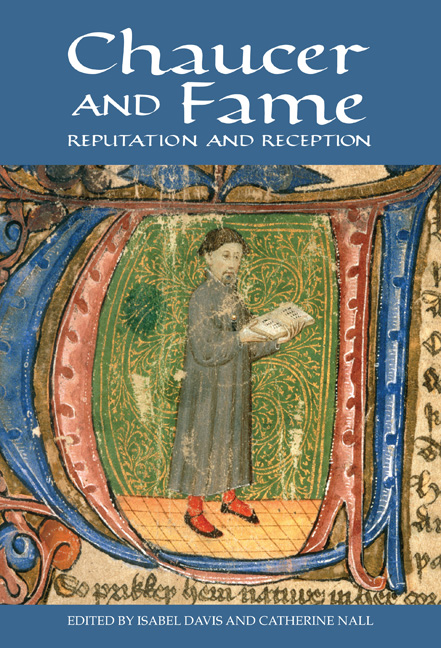Book contents
- Frontmatter
- Contents
- List of Illustrations
- List of Contributors
- Acknowledgements
- Introduction
- 1 Chaucer Joins the Schiera: The House of Fame, Italy and the Determination of Posterity
- 2 ‘I Wolde … han Hadde a Fame’: Dante, Fame and Infamy in Chaucer’s House of Fame
- 3 ‘And kis the Steppes where as thow Seest Pace’: Reconstructing the Spectral Canon in Statius and Chaucer
- 4 ‘I Nolde Sette at al that Noys a Grote’: Repudiating Infamy in Troilus and Criseyde and The House of Fame
- 5 The Early Reception of Chaucer’s The House of Fame
- 6 Fame’s Penitent: Deconstructive Chaucer Among the Lancastrians
- 7 After Deschamps: Chaucer’s French Fame
- 8 ‘Fresch Anamalit Termes’: The Contradictory Celebrity of Chaucer’s Aureation
- 9 Chaucer the Puritan
- 10 Revenant Chaucer: Early Modern Celebrity
- 11 Ancient Chaucer: Temporalities of Fame
- Bibliography
- Index
- Chaucer Studies
1 - Chaucer Joins the Schiera: The House of Fame, Italy and the Determination of Posterity
Published online by Cambridge University Press: 21 May 2021
- Frontmatter
- Contents
- List of Illustrations
- List of Contributors
- Acknowledgements
- Introduction
- 1 Chaucer Joins the Schiera: The House of Fame, Italy and the Determination of Posterity
- 2 ‘I Wolde … han Hadde a Fame’: Dante, Fame and Infamy in Chaucer’s House of Fame
- 3 ‘And kis the Steppes where as thow Seest Pace’: Reconstructing the Spectral Canon in Statius and Chaucer
- 4 ‘I Nolde Sette at al that Noys a Grote’: Repudiating Infamy in Troilus and Criseyde and The House of Fame
- 5 The Early Reception of Chaucer’s The House of Fame
- 6 Fame’s Penitent: Deconstructive Chaucer Among the Lancastrians
- 7 After Deschamps: Chaucer’s French Fame
- 8 ‘Fresch Anamalit Termes’: The Contradictory Celebrity of Chaucer’s Aureation
- 9 Chaucer the Puritan
- 10 Revenant Chaucer: Early Modern Celebrity
- 11 Ancient Chaucer: Temporalities of Fame
- Bibliography
- Index
- Chaucer Studies
Summary
The House of Fame dramatizes Chaucer's interaction with trecento conceptions of the role and the function of the poet, as a number of commentators have shown. This chapter will explore the nature of Chaucer's response to these conceptions, or re-conceptions (of classical ideas), but will also suggest the way in which The House of Fame forms a discursive continuum with The Clerk's Prologue and the conclusion to Troilus and Criseyde – that is, how together they constitute an intertextual discourse on poetic claritas and fama. These works present us with Chaucer's conversations, if you will, with two models of humanism – one of which is Dantean, the other Petrarchan. Crucially, this continuum confirms Chaucer's recognition that there is a debate concerning humanism and fame in trecento Italy, which arose out of what Robin Kirkpatrick has termed ‘the wake of the Commedia’. Chaucer acknowledges two models of poetic fame, the one of ‘the grete poete of Ytaille / That highte Dant’, as he is described in the Monk's Tale (lines 2460–1), the other of ‘Fraunceys Petrak, the lauriat poete … whos retorike sweete / Enlumyned al Ytaille of poetrie’ (Clerk's Prologue, lines 31–3).
One might be forgiven for thinking that Chaucer is being fickle in his poetic affections, seeming to shift allegiance from Dante to Petrarch, but if one looks at what the Monk and the Clerk actually say (not to mention what they actually do and represent as a monk and a clerk per se), then there is an obvious distinction between Chaucer's conception of Petrarch's fama/ claritas and his conception of Dante’s. These formulations of fame constitute two different poetical and political perspectives. Ultimately, Chaucer's conception of poetic renown is informed by both of these figures – and the antique models of fama, gloria and claritas which stand behind them – synthesizing their views into a discourse upon fame which will determine his own posterity.
As I see it, it is best to clarify this conceptual distinction first. Dante, for Chaucer, is ‘the grete poete of Ytaille’, and that genitive is important, as Dante is the poet of vernacular eloquence, the parlar materno as it was spoken by Italians (or Tuscans, at least).
- Type
- Chapter
- Information
- Chaucer and FameReputation and Reception, pp. 21 - 42Publisher: Boydell & BrewerPrint publication year: 2015

